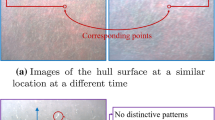Abstract
Autonomous navigation of ships is actively discussed nowadays. It is essential to recognize the surrounding conditions using radars and acquire position information using GPS. However, each of these existing sensors has its own problems. In order to achieve safer autonomous navigation in scenes such as automatic berthing, passing in a narrow line and closing to other ships, an imaging system that integrates various information is essential. Therefore, the authors propose a 3D position measurement method for ships using a stereo camera. In the case of the automatic berthing system, detailed information such as the position of various parts of the hull, heading, roll angle, etc. is necessary. This paper describes a system that measures 3D locations of many parts of ship’s hull with a dense stereo algorithm applied to stereo-pair images captured by cameras set up on land. An experiment to measure an actual ship as a target was conducted. The result indicated that the more disparity data, which meant depth of the ship from the cameras, were obtained by semi-global matching (SGM) even from the featureless images like ship’s hull and the measurement error was within 1 m.









Similar content being viewed by others
References
Rolls-Royce plc, Rolls-Royce and Finferries demonstrate world’s first Fully Autonomous Ferry. https://www.rolls-royce.com/media/press-releases/2018/03-12-2018-rr-and-finferries-demonstrate-worlds-first-fully-autonomous-ferry.aspx. Accessed 30 Dec 2019
Yara International ASA, Yara Birkeland press kit. https://www.yara.com/news-and-media/press-kits/yara-birkeland-press-kit/. Accessed 30 Dec 2019
Shen H, Hashimoto H, Matsuda A, Taniguchi Y, Terada D, Guo C (2019) Automatic collision avoidance of multiple ships based on deep Q-learning. Appl Ocean Res 86:268–288
Xue Y, Clelland D, Lee BS, Han D (2011) Automatic simulation of ship navigation. Ocean Eng 38:2290–2305
Perera L, Carvaho J, Soares C (2009) Autonomous guidance and navigation based on the COLREGs rules and regulations of collision avoidance. In: Proceedings of the international workship “advanced ship design for pollution prevention”, pp 205–216
Perera L, Ferrari V, Santos F, Hinostroza M, Soares C (2015) Experimental evaluations on ship autonomous navigation and collision avoidance by intelligent guidance. IEEE J Oceanic Eng 40(2):374–387
The Ship’s Electric Installation Contractrors’ Association of Japan (2003) The lecture of marine electrical equipment technology (Lader, AIS, VDR, GPS). The Nippon Foundation Libraly
Kocak G, Yamamoto S, Hashimoto T (2013) Detection and tracking of ships using a stereo vision system. Sci Res Essays 8(7):288–303
Ueno M (2000) A GPS-based system for precise shipping guidance and control. J Mar Sci Technol 5(1):9–15
TOKYO KEIKI INC. (2016) Docking Support System DL-3000. https://www.tokyokeiki.jp/Portals/0/images/e/products/pdf/measurement/dl3000.pdf. Accessed 30 Dec 2019
Koden Electronics Co., Ltd. (no date) SRD-303i Ship's docking aid system—laser docking ranger. https://www.koden-electronics.co.jp/en/enindustrial/srd-303i-e. Accessed 30 Dec 2019
Hoshino K, Hara S, Ikemoto Y, Kuroda T (2007) Development and evaluation test of the speedometer for berthing operation support system. Conf Jpn Soc Naval Archit Ocean Eng 5E:151–154 (in Japanese)
Hirata N, Nishijima T, Kakino F (2013) Acquisition of the numerical information for support berthing maneuver by using image processing technology. J Jpn Inst Navig 129:99–104 (in Japanese)
Mizuchi Y, Ogura T, Kim Y, Hagiwara Y, Choi Y (2017) Camera-based measurement for close-distance relative vessel positioning. J Mech Sci Technol 31(4):1899–1907
Lee S, Tzeng C, Kehr Y, Kang C, Huang C (2010) Design and application of an image-processing-based fuzzy autopilot for small-boat approaching maneuvers. J Mar Sci Technol 18(4):558–567
Kiriya N, Imasato M (2006) Marine monitoring technique using omnidirectional camera on berthing. J Jpn Inst Navig 165:88–93 (in Japanese)
Ohyama Y, Ezaki N, Seta H, Hamaji Y (2010) Technology to display image around ship by using Fisheye. J Jpn Inst Navig 122:45–52 (in Japanese)
Nagashima Y, Furuya T, Inaishi M, Kayano J (2012) The study of surveillance around the ship. J Jpn Inst Navig 127:141–148 (in Japanese)
Tall M, Rynne P, Lorio J, Ellenrieder K (2009) Visual-Based Navigation of an Autonomous Tugboat. In: IEEE, OCEANS Oct 26–29
Bui V, Kawai H, Kim Y, Lee K (2011) A Ship berthing system design with four tug boats. J Mech Sci Technol 25(5):1257–1264
Bui V, Kim Y (2011) Development of constrained control allocation for ship berthing by using autonomous tugboats. Int J Control Autom Syst 9(6):1203–1208
Hirschmüller H (2005) Accurate and efficient stereo processing by semi-global matching and mutual information. In: IEEE, CVPR June 20–26
opencv dev team (no date) Camera Calibration and 3D Reconstruction. https://docs.opencv.org/2.4/modules/calib3d/doc/camera_calibration_and_3d_reconstruction.html. Accessed 30 Dec 2019
Zhang Z (2000) A flexible new technique for camera calibration. IEEE Trans Pattern Anal Mach Intell 22(11):1330–1334
Graduate School of Maritime Sciences, Kobe University (no date) Fukaemaru. https://www.edu.kobe-u.ac.jp/gmsc-fukaemaru/ship/index.html#GA. Accessed 30 Dec 2019
Zha D, Jin X, Xiang T (2016) A real-time global stereo-matching on FPGA. Microprocess Microsyst 47:419–428
Cambuim L, Oliveira L, Barros E, Ferreira A (2019) An FPGA-based real-time occlusion robust stereo vision system using semi-global matching. J Real Time Image Proc 30:1–22
Hofmann J, Korinth J, Koch A (2016) A scalable high-performance hardware architecture for real-time stereo vision by semi-global matching. In: IEEE conference of CVPRW, pp 27–35
Jain A, Fell A, Anand S (2017) A parallel architecture for high frame rate stereo using semi-global matching. In: Published in BMVC
Ueno M, Santerre R (2000) A combined method for GPS ambiguity resolution with single-frequency receivers: application for ship berthing. J Inst Navig 41(2):100–111
Nakamura H, Sonobe T et al (2019) Robust positioning method for berthing support using fusion of tightly coupled GNSS carrier phase with IMU and visual odometry. J IPNTJ 10(1):1–12 (in Japanese)
Author information
Authors and Affiliations
Corresponding author
Additional information
Publisher's Note
Springer Nature remains neutral with regard to jurisdictional claims in published maps and institutional affiliations.
About this article
Cite this article
Nomura, Y., Yamamoto, S. & Hashimoto, T. Study of 3D measurement of ships using dense stereo vision: towards application in automatic berthing systems. J Mar Sci Technol 26, 573–581 (2021). https://doi.org/10.1007/s00773-020-00761-2
Received:
Accepted:
Published:
Issue Date:
DOI: https://doi.org/10.1007/s00773-020-00761-2




